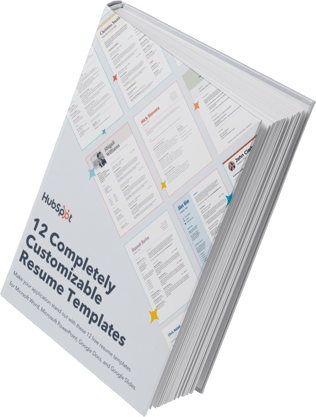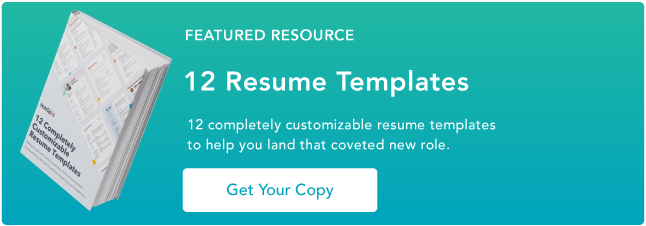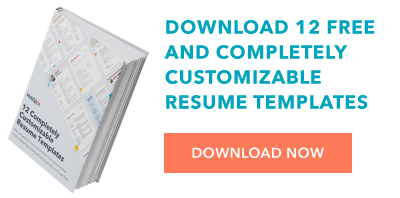What Size Font To Use On Resume
Studies have shown recruiters typically scan a resume for but about six seconds before making a decision on whether an bidder is fit for a function. With only six seconds to demonstrate your qualifications for a position, every particular counts. To evoke a sense of style, professionalism, and uniqueness, it'due south critical you put endeavor and consideration into your font choice. Only, also Times New Roman, which fonts pass the vi-second resume scan? Additionally, which fonts should you avert to ensure your typeface isn't distracting the recruiter from the content itself? Here, we've asked HubSpot recruiters to reveal the seven all-time fonts for your resume in 2019, as well as what they consider in terms of design in full general, so your resume can stand out in the pile. Download Now When speaking with recruiters, information technology quickly became clear that classic fonts are still the best options -- when in doubtfulness, you lot want to make your resume as articulate and piece of cake-to-read as possible, fifty-fifty if it ways forsaking your favorite script font. For instance, Johanna Fleming, a Services Recruiter at HubSpot, told me, "I'm a big fan of the 'classics' for resumes -- Times New Roman, Arial, Calibri, Helvetica, and Cambria. I'm a little former schoolhouse, but I think they are the cleanest and exude professionalism." Additionally, when asked which font size is best, Johanna said, "12 is ideal -- nothing less than x.5." Riley Kundtz, MBA Campus Recruiter at HubSpot, further noted, "I find the archetype formatting and Times font to be helpful when reading a dumbo resume from an experienced MBA candidate." Another HubSpot recruiter, Rich Lapham, concurred, maxim, "I would stick with the classics like Times New Roman or Arial. My personal recommendation would exist Garamond -- I call back it makes information technology look that much more than professional. Recruiters accept an thought of the skills they are looking for on a resume, and so if y'all try a new style or format it can be tougher for recruiters to discover the information they are looking for. Go on it clean and simple." Holly Peterson, a Senior Recruiter at HubSpot, likewise supports more than traditional fonts -- "I really like Arial, Tahoma, and you can't go incorrect with Times New Roman! Anything that is cursive (or also bubbly) is as well difficult to read. For instance, I'd stay clear of Comic Sans." Despite the preference of Times New Roman past some of the recruiters I spoke to, not all recruiters prefer information technology. For instance, Glory Montes, Associate Campus Recruiter at HubSpot, told me, "For me information technology'southward all about legibility and cleanliness. This means I prefer sans-serif fonts like Helvetica, over serif fonts like Times New Roman. Overall, I would simply stay abroad from a font like Times New Roman. Information technology's overused and reminds me of long nights writing form papers in college." Ultimately, yous'll want to consider the position for which you're applying when you're choosing a font. To Celebrity's point, certain more creative roles might benefit from a more unique font than Times New Roman. Paulina Valdez Franco, a Senior Recruiter at HubSpot, also supports fonts other than Times New Roman. She mentioned, "My two favorite fonts for 2019 are Helvetica, if you're looking for a clean and classic expect, and Georgia, if you're going subsequently a more modern and fun look. The latter is also designed to read well on screens." Additionally, Paulina added, "Arial and Calibri are great choices if you want to play it condom." Bridget LeMon, a Technical Campus Recruiter at HubSpot, agrees that "it's totally adequate (and becoming more than common) for candidates to stray away from the resume-norms of Times New Roman and Calibri. Avenir Next and Muna are two great options if you are looking to pause the status quo." However, information technology's important to note most recruiters I spoke with were hesitant to even offer a font at all. For example, Heta Patel, a HubSpot recruiter, said, "I typically don't pay likewise much attending to font. I'm more concerned most whether the resume is formatted in a clean manner -- submitting a PDF is helpful with this, and so your formatting doesn't shift." Kelsey Freedman, a Sales Recruiter at HubSpot, concurred -- "Honestly, I don't care much virtually the font of a resume, as long every bit it's articulate and in PDF format. I typically simply review a resume for 20-30 seconds, then a traditional font is adept. I would propose avoiding script font or bubble font, or something distracting like that." Ultimately, and every bit expected, your content however matters most -- however, a make clean, articulate font will help avoid whatsoever irritability you might cause a recruiter with a distracting, messy design. Ashley Hodder, a Technical Recruiter at HubSpot, seconds this notion -- "I think a resume shouldn't have distracting font, and it should be like shooting fish in a barrel to read. [Simply] what I get about excited about is the content. Depending on the role, I await to see that candidates are sharing direct and compelling snapshots of their work. I wait for indicators that show information orientation, autonomy, and thoughtfulness most business organisation impact." Regular font size for resumes is 12 points, typically in Times New Roman or another archetype, like shooting fish in a barrel-to-read font. Larger fonts are acceptable for headings, your proper name, or titles of sections. If yous're having trouble plumbing equipment your content on ane page, y'all might effort making your font 10.v points, just don't go lower than that. Editor's annotation: This mail was originally published in November 2018 and has been updated for comprehensiveness. ![→ Download Now: 12 Resume Templates [Free Download]](https://no-cache.hubspot.com/cta/default/53/4ec95757-585e-40cf-9189-6b3885074e98.png)
Best Fonts for Resume
Featured Resource:12 Free Resume Templates

Resume Font Size


Originally published Oct 19, 2020 7:00:00 AM, updated August 25 2021
What Size Font To Use On Resume,
Source: https://blog.hubspot.com/marketing/best-font-resume
Posted by: baldwinfrant1961.blogspot.com


0 Response to "What Size Font To Use On Resume"
Post a Comment